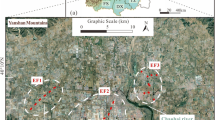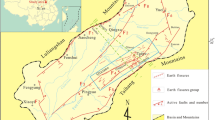Abstract
Liangjia Village earth fissure, one of the 79 earth fissures along the Kouzhen-Guanshan fault located in the northern Weihe Basin, causes severe damage to buildings and farmlands. Since the late 1950s, 40 earth fissures have occurred in a similar east-west (EW) direction parallel to the Kouzhen-Guanshan fault, and a further 39 earth fissures have occurred with north-west, east-north, or north-east orientations intersecting the fault. In this study, a case study of Liangjia Village earth fissure was conducted to investigate the mechanisms of fissure generation in detail. Geotechnical and geophysical methods including measurements, trenching, drilling, and seismic exploration were used to reveal the basic characteristics, geological background, and origin model of the Liangjia Village earth fissure. This earth fissure, with a total length of 800 m in 2014, runs EW parallel to the Kouzhen-Guanshan fault, and it has damaged buildings and farmlands by forming sinkholes, gullies, subsidence, and a scarp. The trenching results indicated that this fissure underwent multi-phase activity. Analysis of geological drilling and shallow seismic profiling results showed that the fissure also possessed characteristics of a synsedimentary fault. Regarding its genesis, the fissure was formed through the combined actions of three factors: an earthquake created the fissure, the Kouzhen-Guanshan fault controlled its development, and loess erosion and groundwater runoff subsequently enlarged the fissure. Regional extension first generated many buried faults along the hanging wall of the Kouzhen-Guanshan fault before seismic activity caused the buried faults to propagate to the surface, where loess erosion and ground-water runoff promoted the formation of the current earth fissure.
Similar content being viewed by others
References
Ayalew L, Yamagishi H, Reik G (2004). Ground cracks in Ethiopian Rift Valley: facts and uncertainties. Eng Geol, 75(3–4): 309–324
Allis R G (2000). Review of subsidence at Wairakei field, New Zealand. Geothermics, 29(4–5): 455–478
El Baruni S S (1994). Earth fissures caused by groundwater withdrawal in Sarir south agricultural project area, Libya. Hydrogeol J, 2(1): 45–52
Bonini L, Basili R, Toscani G, Burrato P, Seno S, Valensise G (2015). The role of pre-existing discontinuities in the development of extensional faults: an analog modeling perspective. J Struct Geol, 74: 145–158
Budhu M (2011). Earth fissure formation from the mechanics of groundwater pumping. Int J Geomech, 11(1): 1–11
Burbey T J (2002). The influence of faults in basin-fill deposits on land subsidence, Las Vegas Valley, Nevada, USA. Hydrogeol J, 10(5): 525–538
Holzer T L, Galloway D L (2005). Impacts of land subsidence caused by withdrawal of underground fluids in the United States. Rev Eng Geol, 16(08): 87–99
Hernandez-Marin M, Burbey T J (2010). Controls on initiation and propagation of pumping-induced earth fissures: insights from numerical simulations. Hydrogeol J, 18(8): 1773–1785 (in French)
Hernandez-Marin M, Burbey T J (2012). Fault-controlled deformation and stress from pumping-induced groundwater flow. J Hydrol (Amst), 428–429(4): 80–93
Holzer T L (1980). Faulting caused by groundwater level declines, San Joaquin Valley, California. Water Resour Res, 16(6): 1065–1070
Hu R L, Yue Z Q, Wang L C, Wang S J (2004). Review on current status and challenging issues of land subsidence in China. Eng Geol, 76(1–2): 65–77
Jachens R C, Holzer T L (1982). Differential compaction mechanism for earth fissures near Cas Grande, Arizona. Geol Soc Am Bull, 93(10): 998–1012
Jia Z J, Lu Q, Peng J, Qiao J, Wang F, Wang S, Zhao J (2020). Analysis and comparison of two types of ground fissures in Dali County in the Weihe Basin, China. Environ Earth Sci, 79(1): 38.1–38.
Lee C F, Zhang J M, Zhang X Y (1996). Evolution and origin of the ground fissures in Xi’an, China. Eng Geol, 43(1): 45–55
Leonard R J (1929). An earth fissure in Southern Arizona. J Geol, 37(8): 765–774
Li X, Wang S J, Liu T Y, Ma F S (2004). Engineering geology, ground surface movement and fissures induced by underground mining in the Jinchuan Nickel Mine. Eng Geol, 76(1–2): 93–107
Li Y L, Yang J C, Hu X M (2000). Origin of ground fissures in the Shanxi Graben System, northern China. Eng Geol, 55(4): 267–275
Li Y H, Wang Q L, Cui D X, Hao M (2016). Analysis on the faulting origin of Kouzhen-Guanshan Fault in Weihe Basin. Journal of Geodesy and Geodynamics, 36(8): 669–673 (In Chinese)
Liu N N, Feng X, Huang Q, Fan W, Peng J, Lu Q, Liu W (2019). Dynamic characteristics of a ground fissure site. Eng Geol, 248: 220–229
Mi F S, Han H Y, Jin J Q, Liu H Y (1993). Nowadays active features of the Kouzhen-Guanshan Fault. Journal of Xi’an College of Geology, 15(2): 40–47(in Chinese)
Pampeyan E H, Holzer T L, Clark M M (1988). Modern ground failure in the Garlock fault zone, Fremont Valley, California. Geol Soc Am Bull, 100(5): 677–691
Pacheco J, Arzate J, Rojas E, Arroyo M, Yutsis V, Ochoa G (2006). Delimitation of ground failure zones due to land subsidence using gravity data and finite element modeling in the Querétaro valley, México. Eng Geol, 84(3–4): 143–160
Pacheco-Martínez J, Hernandez-Marín M, Burbey T J, González-Cervantes N, Ortíz-Lozano J Á, Zermeño-De-Leon M E, Solís-Pinto A (2013). Land subsidence and ground failure associated to groundwater exploitation in the Aguascalientes Valley, México. Eng Geol, 164(18): 172–186
Peng J B (2012). Fissures in Xi’an. Beijing: Science Press (in Chinese)
Peng J B, Chen L, Huang Q, Men Y, Fan W, Yan J (2013). Physical simulation of ground fissures triggered by underground fault activity. Eng Geol, 155: 19–30
Peng J B, Qiao J W, Leng Y Q, Wang F Y, Xue S Z (2016a). Distribution and mechanism of the ground fissures in the Wei River Basin, the origin of the Silk Road. Environ Earth Sci, 75(8): 718–730
Peng J B, Xu J S, Ma R Y, Wang F Y (2016b). Characteristics and mechanism of the Longyao ground fissure on North China Plain, China. Eng Geol, 214: 136–146
Peng J B, Wang F, Cheng Y, Lu Q (2018). Characteristics and mechanism of Sanyuan ground fissures in the Weihe Basin, China. Eng Geol, 247: 48–57
Phien-wej N, Giao P H, Nutalaya P (2006). Land subsidence in Bangkok, Thailand. Eng Geol, 82(4): 187–201
Ramelli A R (2003). Ground cracks associated with the 1994 Double Spring Flat earthquake, West-Central Nevada. Seismol Soc Am Bull, 93(6): 2762–2768
Rudolph D L, Cherry J A, Farvolden R N (1991). Groundwater flow and solute transport in fractured lacustrine clay near Mexico City. Water Resour Res, 27(9): 2187–2201
Sarkar I (2004). The role of the 1999 Chamoli Earthquake in the formation of ground cracks. J Asian Earth Sci, 22(5): 529–538
Sun P, Peng J B, Chen L W, Yin Y P, Wu S R (2009). Weak tensile characteristics of loess in China—an important reason for ground fissures. Eng Geol, 108(1–2): 153–159
Wang F Y, Peng J, Lu Q, Cheng Y, Meng Z, Qiao J (2019a). Mechanism of Fuping ground fissure in the Weihe Basin of northwest China: fault and rainfall. Environ Earth Sci, 78(14): 407
Wang F Y, Peng J, Meng Z, Qiao J, Wen H, Ma P, Liu Y, Jia Z, Zhao J (2019b). The origin and impact of the Shizhuang ground fissure, Yingxian area, Datong Basin, China. Eng Geol, 261: 105283
Wang F Y, Peng J, Chen Z, Wang Q, Meng Z, Qiao J, Zhao J (2020). Development characteristics and mechanisms of damage-causing urban ground fissures in Datong City, China. Eng Geol, 271: 105605
Williams F M, Williams M A J, Aumento F (2004). Tensional fissures and crustal extension rates in the northern part of the Main Ethiopian Rift. J Afr Earth Sci, 38(2): 183–197
Xu J S, Meng L C, An H B, Wang L Y (2015). The bending mechanism of Anping ground fissure in the Hebei Plain, North China. Environ Earth Sci, 74(9): 6859–6870
Xu Y J, Shen-Tu B, Wang Y (1988). A preliminary study of the characteristics of the activity of the Northern Boundary Fault Belt of Weihe Basin. Ssmology and Geology, 10(4): 77–87 (in Chinese)
Youssef A M, Sabtan A A, Maerz N H, Zabramawi Y A (2014). Earth fissures in Wadi Najran, Kingdom of Saudi Arabia. Nat Hazards, 71(3): 2013–2027
Zang M D, Peng J, Qi S (2019). Earth fissures developed within collapsible loess area caused by groundwater uplift in Weihe watershed, northwestern China. J Asian Earth Sci, 173: 364–373
Acknowledgements
The authors would like to thank the China Geological Survey for supporting this effort, and would also like to acknowledge the tremendous help and support from all who participated in the work carried out in this study. This study was funded by the National Basic Research Program of China (No. 2014CB744700), the High Speed Railway Joint Fund of NSFC (No. U1934208), the Key R & D Program of Jiangxi Province, China (No. 20202BBGL73079), the CMEC Technology Incubation Project (CMEC-KJFH-2018-02), the National Natural Science Foundation (Grant No. 41702298), Supported by the Fundamental Research Funds for the Central Universities, CHD (Nos. 300102260402 and 300102269203) and the National Geological Survey of China (Nos. 121201001000150122 and DD20160235). We thank the anonymous reviewers and the editor for their helpful comments and suggestions that helped in improving the manuscript. No potential conflict of interest was reported by the author(s).
Author information
Authors and Affiliations
Corresponding authors
Rights and permissions
About this article
Cite this article
Zhu, J., Qiao, J., Wang, F. et al. Development characteristics and formation analysis of the Liangjia Village earth fissure in the Weihe Basin, China. Front. Earth Sci. 14, 758–769 (2020). https://doi.org/10.1007/s11707-020-0840-2
Received:
Accepted:
Published:
Issue Date:
DOI: https://doi.org/10.1007/s11707-020-0840-2




